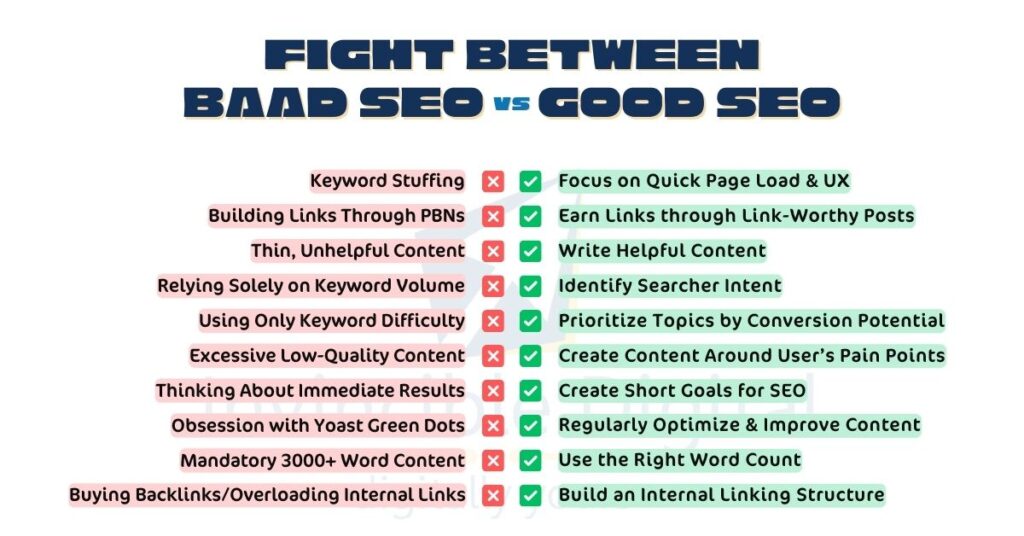Are You Doing Your SEO Right? Good SEO vs. Bad SEO

Today, almost every online destination — website, blog, social network, or app — everyone goes through a search engine, and SEO is the compass that guides you in that online journey. How you do the SEO creates the difference between your website basking in the limelight or getting lost in the shadows. Good SEO practices are like a gentle breeze that propels your content to the forefront, while bad practices are the turbulent storms that can sink your online ship. Today, let’s explore the pitfalls of bad SEO that you should avoid at all costs and delve into good SEO practices that can help catapult your website to the top of search results.
Let’s get started!
Bad SEO:

1. Keyword Stuffing:
Excessively incorporating keywords into content makes it seem unnatural and unhelpful. For instance, let’s consider a blog post discussing the “finest coffee shops in New York” that has the phrase “finest coffee shops in New York” in every other sentence, to the extent that it hinders the readability of the content. Repeating your keyword X number of times in content doesn’t work anymore, this is not 90s search engine. Today this practice only annoys readers and triggers penalties from search engines.
2. Building Links through PBNs (Private Blog Networks):
Private Blog Networks (PBNs) are networks of websites created with the sole purpose of artificially inflating the backlink profile of a primary website. Many SEOs use PBNs in the hope of gaining control over anchor text and generating a high number of backlinks quickly. For instance, if a fitness website links to various Web 2.0 websites through a PBN, it is considered a manipulative link-building practice. Search engines like Google can detect such schemes and may penalize the involved sites.
3. Producing Thin, Unhelpful Content:
Any content lacking depth and value is considered thin content. Imagine searching for how to reach Goa and finding one blog that simply tells you to pack your bags, go to the airport, and catch a flight to Goa. And the content is filled with affiliate or promotional links. Would you bother reading such a blog? I certainly wouldn’t, and I would make sure to never use that website for the information again. Blog posts that fail to provide meaningful information are unlikely to rank well in search results or convert visitors into customers. This kind of content doesn’t address users’ queries or provide valuable insights, which are crucial factors in search engine rankings.
Read: Seven tips to optimize your blog like a Pro!!
4. Relying Solely on Keyword Tools:
If you rely solely on keyword tools and select keywords purely based on search volume, without considering the user intent, demographics, or competition, all your efforts may go in vain.
For example, if I’m a new website selling shoes, rather than targeting high volume low intent keywords like “Shoes”(AMS 823,000), “shoes for women”(AMS 301,000), or “white shoes”(AMS 135,000), I’d target clear intent, long tail keywords like “best walking shoes for women”(AMS 2,400), “white sneakers women”(AMS 8,100) and “loafers for women”(AMS 33,100)
Targeting high-volume keywords that lack a clear intent can make your SEO directionless, leading to high bounce rates and low engagement.
5. Using Metrics Like Keyword Difficulty in Isolation:
Similar to volume, looking at only keyword difficulty metrics to make your target keyword selection is the wrong practice. Keyword difficulty metrics provide valuable insights and should be “one of the determinants”, but they shouldn’t be the sole determinant for keyword selection. For instance, a keyword might have low difficulty but also have very low search volume. After all, it’s totally understandable that fewer people are competing on keywords with low volume.
6. Posting Excessive Low-Quality Content:
Posting more content is one of the first tasks every SEO adds to their strategy. However, each piece of posted content should have substance; otherwise, it will not be anything more than glorified garbage. If a website prioritizes quantity over quality by publishing several low-quality articles in one day, it can harm the overall quality of the website. Low quality can not only deter users but also hurt SEO rankings over time.
7. Thinking SEO Yields Immediate Results:
Search engine optimization (SEO) is a long-term strategy that requires patience and proper planning. Expecting instant results can lead to frustration and tempt you to use unethical black hat techniques that can backfire and cause sitewide penalization. *It takes time to build authority and earn high, sustainable rankings. Therefore, setting the right expectations beforehand is crucial for achieving success in SEO.*
8. Keyword Stuffing in Headings:
Keyword stuffing in headlines is as bad as in content. It makes content awkward and repetitive. Google can spot such practices and can penalize the website for the same. Keyword stuffing in shape or form is a big NO-NO for any website.
9. Obsession with Yoast SEO Dots:
While using any SEO tool like Yoast, one should keep in mind that the tool is there just for guidance and should not be followed with a blind eye. Overemphasizing achieving all green dots in Yoast SEO or similar plugins is an incoherent way of doing on-page SEO. Additionally, getting a high score in the tool does not guarantee anything unless you take care of content quality and relevance. *These plugins should serve as guidelines, not strict rules.
10. Mandatory 3000+ Word ‘Skyscraper’ Content:
“Longer the content, better the rankings” is an outdated approach. With people’s attention spans being shorter than that of goldfish and the availability of SGE/ChatGPT/Bing Chat, not everybody has the time and reason to read a 3000-word article. Also, not every topic requires lengthy content. Creating ultra-long ‘skyscraper’ content, when a concise piece would suffice, no longer guarantees high rankings, as it can dilute the value of your content.
11. Publishing and Sharing Links Hastily:
Simply publishing a new article and sharing it on social media right away may not guarantee a high engagement rate or traffic. In fact, it can have a negative impact. Therefore, before sharing any content, it’s crucial to double-check for proper optimization and correction to ensure the best possible results.
12. Buying Backlinks and Overloading Internal Links:
Purchasing backlinks from untrustworthy sources, such as guest post farms or hacked, spammy, or non-relevant websites, can harm your site’s credibility and result in an inflated spam score. Additionally, excessive use of irrelevant internal linking can negatively impact user experience. These practices may trigger search engine penalties, undermining your SEO efforts and resulting in long-term ranking loss.
The Journey From Bad SEO to Good SEO

These are some outdated SEO practices that used to work in the past. However, with time, some of these bad SEO practices turned into spamming, while others evolved to align with modern search algorithms. If you’re still following these practices, you’re only contributing to the deterioration of your website’s integrity, harming user experience, and risking penalties from search engines.
It is better to stick to modern and ethical SEO practices that can aid in the long-term growth of your website. A good SEO strategy prioritizes user-centric, high-quality content while adhering to best practices and avoiding manipulative tactics. Search engines today require new SEO practices to improve your ranking in SERPs. What are those “Good SEO” practices? Let’s discuss!
Good SEO:

1. Write Helpful Content:
According to Google’s guidelines for helpful content, “Google’s automated ranking systems are designed to present helpful, reliable information that’s primarily created to benefit people, not to gain search engine rankings, in the top search results.” This statement alone is enough to emphasize the importance of creating helpful content. Craft content that genuinely solves problems or provides information. For instance, if you run a home improvement website, create a guide on fixing common plumbing issues, complete with step-by-step instructions and troubleshooting tips. Valuable content not only attracts visitors but also keeps them engaged.
2. Identify Searcher Intent:
Rather than robotically following keyword tools for the highest volume, it is essential to understand why users are searching for a particular keyword. You should be able to recognize whether they are looking for information, a product, or a solution. For instance, someone searching for “best running shoes” is likely in the market to make a purchase, whereas someone searching for “how to improve running stamina” seeks informative content. Determine which keyword matches the intent of your website and tailor your content to match their intent for better user satisfaction and rankings.
3. Build an Internal Linking Structure:
Develop a structured network of internal links connecting related pages. If you have an e-commerce site, you can link from product pages to relevant blog posts with tips on how to use those products.
Strategic internal linking is a vital component of technical SEO that guides users through your site, distributes link equity effectively, and enhances user experience. Unfortunately, interlinking is often overlooked by most SEOs. Newcomers to SEO may neglect interlinking when their website has only a few pages, thinking it’s not necessary. However, as the website grows and more pages are added, managing interlinks becomes increasingly challenging. Therefore, it’s essential to create an interlinking strategy, regardless of the number of pages your website has, and diligently follow through with it. This will not only improve your website’s SEO but also provide a better user experience to your visitors.
4. Earn Links through Link-Worthy Posts:
Obtaining quality backlinks has always been a significant challenge for SEO. Links are an essential component of SEO, and one of the simplest methods to acquire numerous backlinks and maintain continuity is by creating content that naturally attracts links. High-quality, original, and informative articles can be a valuable resource for other websites and bloggers in your field. This often results in backlinks, which enhances your site’s authority. However, it’s crucial to note that creating lengthy content isn’t the only way to attract backlinks. The length of the content should be just enough to explain the topic in such a way that people use your content as a reference. So, creating comprehensive reports or articles about industry trends can be an effective way to attract backlinks, but make sure the content is of high quality and informative.
5. Talk to Customers and Create Content Around Their Pain Points:
Engage with your audience through surveys, reviews, or social media. If you operate a software company and customers express difficulties with a specific feature, address it in a detailed troubleshooting guide. Engage with your audience to understand their pain points and concerns. Create content that directly addresses these issues, establishing your site as a valuable resource.
6. Prioritize Topic Ideas by Conversion Potential:
Focusing on topics and keywords that have the potential to convert visitors into customers is more effective than targeting keywords with the lowest KD. There’s no point in ranking high for a keyword that has zero potential to generate business. For instance, if you operate an online bookstore, producing content about “best book club recommendations” can attract readers who are more likely to make a purchase. It is a better strategy than trying to target a keyword like “5 banned books”.
7. Find Gaps in the SERP and Competitors’ Content:
It is important to actively monitor the search engine results page for your target keywords in order to identify any gaps. If you notice that none of your competitors have provided a beginner’s guide on a particular topic, take advantage of the opportunity to create one.
8. Regularly Optimize and Improve Existing Content:
There is a distinction between old content and outdated content. It is important to understand this difference and not allow older content to become outdated. Suppose you manage a travel blog, and there are modifications in visa regulations for a popular destination. In that case, you should update your existing articles to reflect the new requirements. While it is essential to keep creating new content, you should not forget about existing content. Therefore, it is advisable to set up a schedule for content refreshment. Fresh and up-to-date content always ranks better.
9. Create Short Goals for SEO:
To see quicker improvements, it is important to focus on specific SEO tasks. For example, dedicate a week to optimizing title tags, meta descriptions, and header tags for the key pages on your e-commerce site. These short bursts of high-output SEO work can lead to quicker results. Concentrating on specific tasks, such as fixing technical issues or optimizing key pages, can result in rapid improvements.
10. Focus on Quick Page Load and User Experience:
It doesn’t matter how visually appealing your website is, if it takes too long to load, users won’t stick around. Ensure that your website loads quickly and provides a seamless experience. If users can move from one page to another without lag, it increases the chances of conversions. For instance, if your online store is fast, visitors can easily view multiple products, make comparisons, and complete purchases. However, if it is slow and laggy, users may leave the website after their first visit.
11. Optimize for Topics, Entities, and Overall Content Coverage:
Go beyond individual keywords and create comprehensive content. If you’re running a tech blog, a comprehensive guide on a popular smartphone should cover its specifications, features, user reviews, and frequently asked questions. Go beyond mere keywords and consider topics and entities. Create comprehensive content that covers all aspects of a subject, boosting your authority in the eyes of search engines.
12. Use the Right Word Count:
There is no such thing as content being too short or too long. Rather, it can be classified as either thin content or helpful content. Therefore, it is important to focus on delivering information in the most helpful way possible, instead of worrying about the word count of the content. It is possible for 300-word content to rank just as well as 1000-word content on the same topic. Unnecessarily filling the content with fluff just to achieve a certain word count is not recommended. Surprisingly, concise and informative content often performs better. For example, a clear and concise recipe blog without unnecessary verbosity will receive more engagement than a lengthy one.
13. Write with Distribution in Mind:
Your content should have a high repurpose value. Plan content that can be repurposed across multiple channels in various ways. If you produce an in-depth article about eco-friendly gardening, consider breaking it down into a series of social media posts, newsletters, infographics, or even a podcast episode. This will help you reach a wider audience and maximize impressions with a single piece of information.
14. Use AI to Scale Content:
Utilize AI tools to streamline content production, updates, and optimization. Nowadays, AI tools are available for almost every aspect of content creation. Employ these tools to efficiently scale content creation, saving time and reducing costs while upholding quality standards. For instance, an e-commerce website could use AI to generate product descriptions automatically based on specifications, which saves time while ensuring consistency and quality.
Read: AI Assistant vs. Search Engine
When it comes to SEO, the choices you make will have a significant impact on your rankings. SEO isn’t a one-and-done task, but rather a continuing commitment to maintaining your online presence. Stay informed, adjust to changes, and always prioritize user experience by offering relevant and useful content. By embracing good SEO practices and avoiding bad ones, you’ll not only improve your online visibility but also contribute to a more informative and helpful internet. So, start following these SEO practices to fill your digital journey with success, high rankings, and organic traffic.
Recommended Posts

SEO vs SEM: Does SEM Help With SEO?
April 15, 2024

How to Symphonise AI and SEO
January 31, 2024

2024 Search Engine Optimization Checklist
January 1, 2024

